This post contains affiliate links.
Learning how to play a musical instrument can be overwhelming because of all the music-related concepts to memorize. The 9 following music flashcards can be used at your own pace or with the help of a music teacher. They cover:
- Rhythmic patterns and time signatures
- Music symbols and terms
- Musical instruments
Music Flashcards Comparison Table
This table contains music flashcards that can be used by music or piano teachers.
| Game | Age | Notions learned | Price | Rating |
| Rhythm Cards | 4+ | Rhythm patterns | $$$ | ★★★★☆ |
| English Flashcard Instrument | 4+ | Instruments | $ | ★★★☆☆ |
| Music Flashcards | 6+ | Symbols, notes, rhythms | $ | ★★★★★ |
| General Music | 6+ | Notes | $$ | ★★★☆☆ |
| Music Theory Flashcard | 6+ | notes, scales, chords | $$$ | ★★★★☆ |
| Complete Color-Coded Flashcards | 6+ | notes, symbols, terms | $ | ★★★★★ |
| Alfred’s Basic Piano Library Flashcards | 6+ | notes, symbols, terms | $$ | ★★★☆☆ |
| Music Note Flashcards | 6+ | Notes | $$$ | ★★★★☆ |
| Chord Cards | 7+ | Chords | $$ | ★★★☆☆ |
Music Flashcard Games for Primary School
Rhythm Cards (NotePerfect Project)
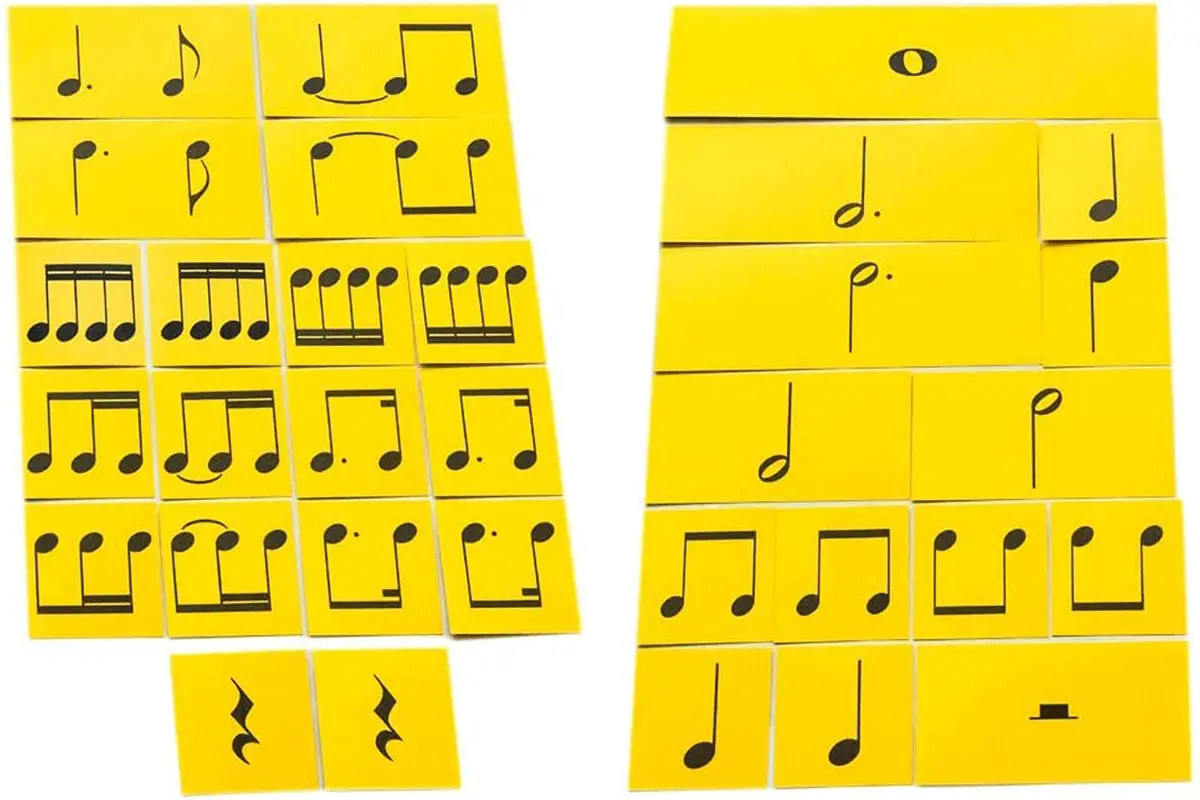
★★★★☆
For Families and Teachers | Age 4+ | 1-4 Students
Rhythm Cards contains 32 flashcards and 4-time signature cards.
contains 32 flashcards and 4-time signature cards.
The set is good for presenting time signatures visually. The length of the cards matches the note value. It gives children a clue about the right number of beats.
Also, the cards are laminated so adding and erasing notes on top of them are convenient and helpful in teaching and creating patterns.
I recommend Rhythm Cards to music teachers because the cards are easy to use and have accurate content. They can be used in several learning activities such as:
- Recitation
- Memory game
- Activities like clapping according to note values
English Flashcard-Instrument (Richardy)

★★★☆☆
For Families and Teachers | Age: 4+ | 1-4 Students
English Flashcard Instrument is a good tool for expanding English vocabulary in music.
is a good tool for expanding English vocabulary in music.
It is composed of 20 double-sided cards where:
- The front side contains the picture and name of the instrument.
- The reverse side has the name of the instrument, a pronunciation guide, a code that you can scan to watch the pronunciation video, and an example of how to use the instrument name in a sentence.
Music Flashcards (Hal Leonard)
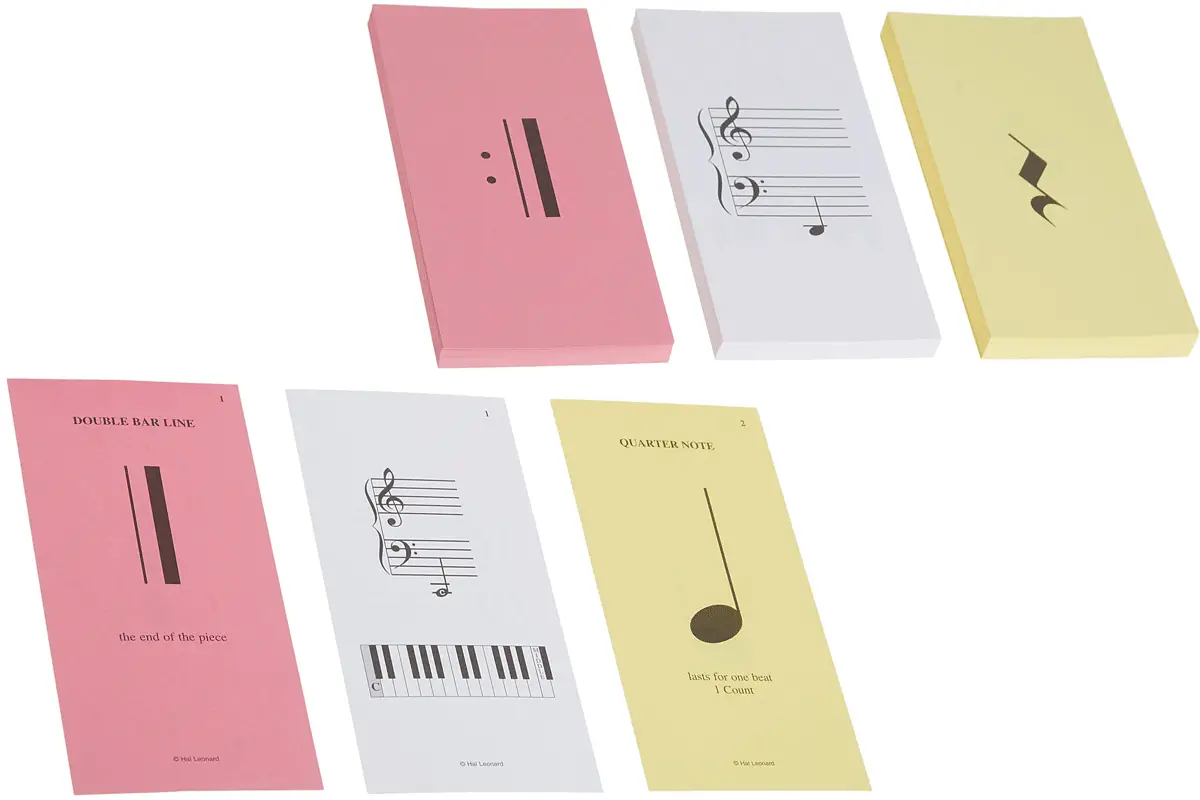
★★★★★
For Families and Teachers | Age: 6+ | 1-4 Students
Music Flashcards is composed of 120 color-coded flashcards that are divided into the following:
is composed of 120 color-coded flashcards that are divided into the following:
- Pink– symbols, terms, and intervals
- White– notes and reading patterns
- Yellow– values and rhythm patterns
The cards are double-sided. The rhythm set consists of 17 two-measure pattern cards and 13 four-measure pattern cards. Hence, students will learn a total of 60 different rhythm patterns:
I like the suggestions on how to use the cards in the classroom such as:
- Clapping hands
- Tapping knees
- Playing a percussive instrument
- Playing the key on the piano
Music Flashcards are very useful as they cover topics that are usually intimidating for beginners, especially the notes and symbols, but it is also great that rhythms are provided.
are very useful as they cover topics that are usually intimidating for beginners, especially the notes and symbols, but it is also great that rhythms are provided.
General Music (Notes & Strings)
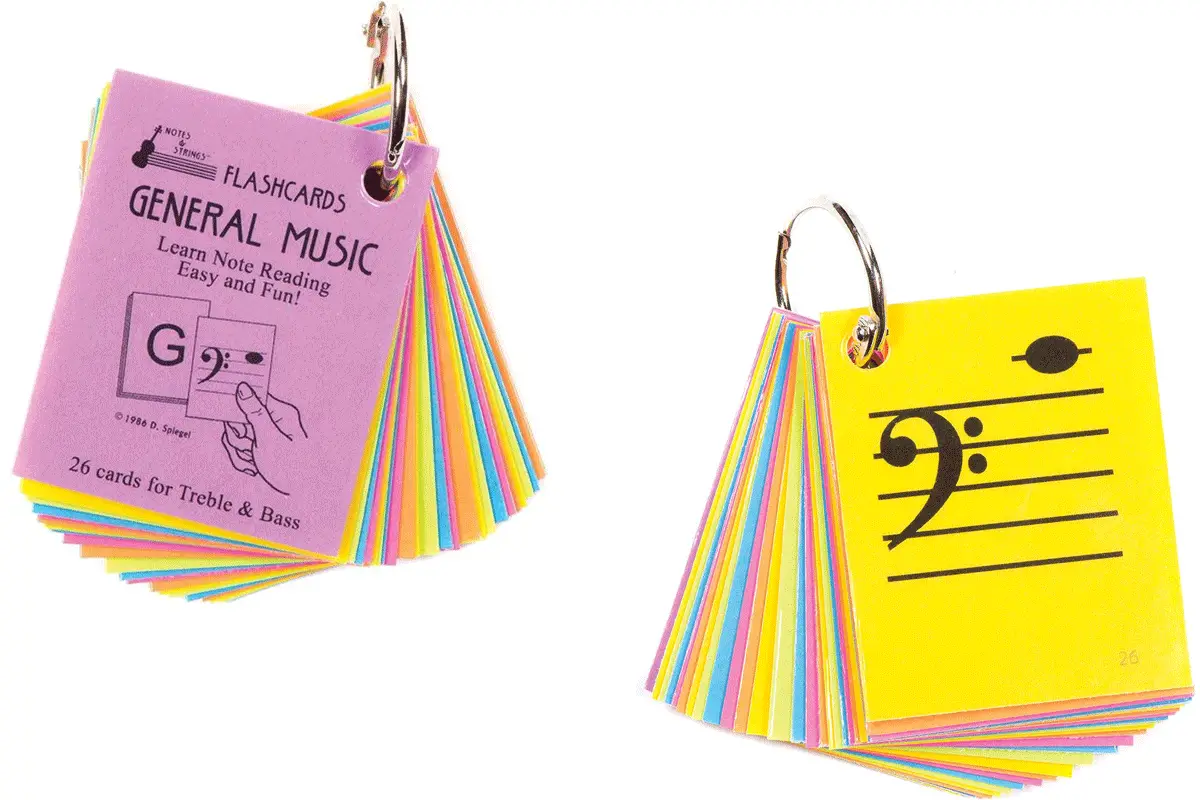
★★★☆☆
For Families and Teachers | Age 10+ | 1-2 Students
General Music features 26 colorful laminated cards that teach treble and bass clef from one leger line below and above the staff.
features 26 colorful laminated cards that teach treble and bass clef from one leger line below and above the staff.
The cards are double-sided where the front side contains the note while the reverse side has the name of the note. They are self-correcting (answers can be found at the bottom of the card).
The cards are few so playing a memory game or quiz game with two players is an interesting way to use them.
Music Theory Flashcard (Notes & Strings)
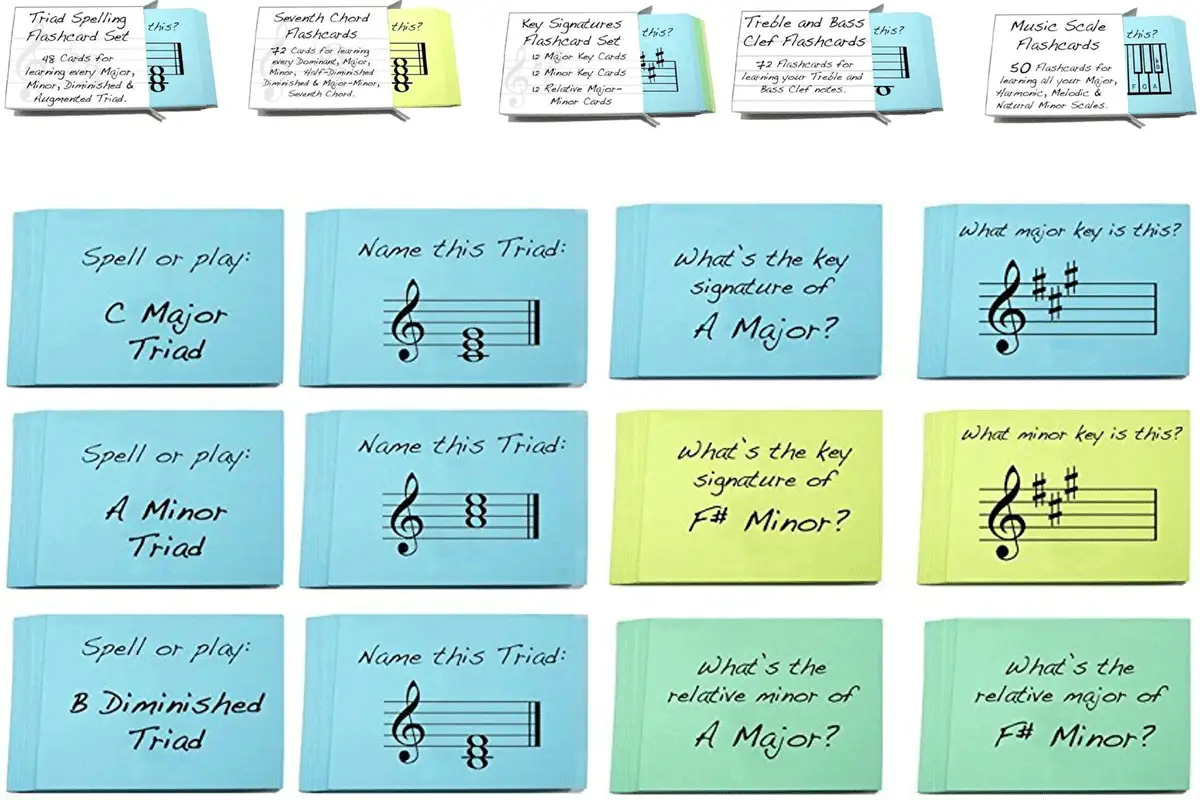
★★★★☆
For Families and Teachers | Age: 6+ | 1-4 Students
Music Theory Flashcard is helpful for music majors and piano students because the five sets of cards deal with key signatures, treble clef, bass clef, music scale, seventh chord, and triad.
is helpful for music majors and piano students because the five sets of cards deal with key signatures, treble clef, bass clef, music scale, seventh chord, and triad.
The cards are easy to read and can be learned at one’s pace. The illustrations are simple and neat.
Complete Color-Coded Flashcards (Alfred Music)
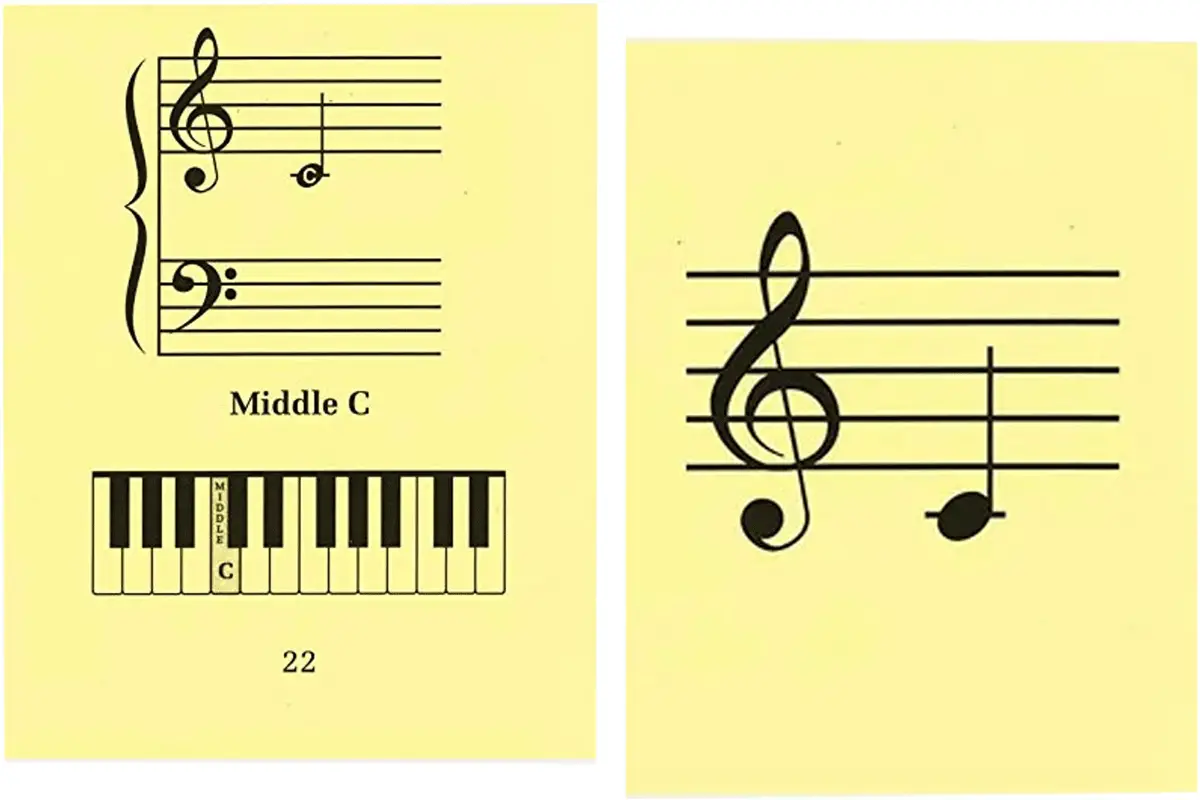
★★★★★
For Families and Teachers | Age: 6+ | 1-4 Students
In Complete Color-coded Flashcards , students will learn notes on the staff, note and rest values, time signatures, tempo marks, dynamic signs, melodic and harmonic intervals, and more.
, students will learn notes on the staff, note and rest values, time signatures, tempo marks, dynamic signs, melodic and harmonic intervals, and more.
The set has 89 double-sided and color-coded flashcards, with a notion on one side and an explanation on the other side. The cards are best suited for piano students as the topic coverage is a bit piano specific.
Alfred’s Basic Piano Library Flashcards (Alfred Music)

★★★☆☆
For Families and Teachers | Age: 6+ | 1-4 Students
Alfred’s Basic Piano Library Flashcards is comprised of two sets of 102 double-sided flashcards (sold separately) that are used for reviews of the corresponding piano lessons book from the publisher (levels 1, 2 and 3).
is comprised of two sets of 102 double-sided flashcards (sold separately) that are used for reviews of the corresponding piano lessons book from the publisher (levels 1, 2 and 3).
Music Note Flashcards (Shionkai Music Publishing)

★★★★☆
For Families and Teachers | Age: 6+ | 1-4 Students
Music Notes Flashcards was inspired by the teaching experience of piano teacher Mari Shiraishi.
was inspired by the teaching experience of piano teacher Mari Shiraishi.
This set contains 100 double-sided cards that enable students to read notes quickly.
- The front side features the music score
- The reverse side of the card shows the following:
- Overall view of the keyboard
- Location of the note on the keyboard
- The distance of the note being studied from middle C note which was grayed out on the keyboard at the bottom of the card
With Music Notes Flashcards you can learn treble clef, bass clef, sharps, flats, double sharps, double flats, and more.
Chord Cards (Divine Muzik LLC)

★★★☆☆
For Families and Teachers | Age 7+ | 1-4 Students
Chord Cards is used to memorize chords for piano, bass, or guitar. It is composed of 72 color-coded flashcards that are aimed at studying:
is used to memorize chords for piano, bass, or guitar. It is composed of 72 color-coded flashcards that are aimed at studying:
- Chord structures
- Intervals
- Inversions
- Chord names
The cards are double-sided. One side contains the keys to play the chord while the other side shows how to position your fingers to do the chord on the piano.
Aside from using these flashcards for memory games, teachers can use this in a speed game where children can be asked to read, write, or perform the chord notation on the card.
Edudingo.com is a participant in the Amazon Services LLC Associates Program, an affiliate advertising program designed to provide a means for sites to earn advertising fees by advertising and linking to Amazon.com. We also participate in other affiliate programs which compensate us for referring traffic.

